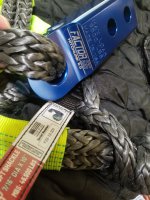ToyodaAddict1980
Well-known member
- Joined
- Mar 22, 2021
- Member Number
- 3706
- Messages
- 126
Ive been using factor 55 hitch links with soft shackles. I take it that edge is probably to sharp and I should be using a steel shackle? I feel weird about hooking a steel shackle to the aluminum hitch. The hitch would become the weak link?
3/4'' steel shackle minimum breaking load 57,000
factor 55 link 51,000
7/8'' rope 28,600 and 3/4 rope 19,000
So far I've only been using this stuff for little bumps. On the rare occasion something is really stuck, we winch.
Back in the day we used chains , cables, and worn out straps rejected from the job site
I'm trying to do better now

3/4'' steel shackle minimum breaking load 57,000
factor 55 link 51,000
7/8'' rope 28,600 and 3/4 rope 19,000
So far I've only been using this stuff for little bumps. On the rare occasion something is really stuck, we winch.
Back in the day we used chains , cables, and worn out straps rejected from the job site

I'm trying to do better now

 . I don't have one yet, but definitely on my radar.
. I don't have one yet, but definitely on my radar.


 new hero status achieved,
new hero status achieved,
